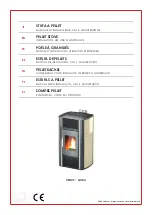
CONGRATULATIONS!
You have purchased a heater from North America's oldest manufacturer of wood and coal burning products. Our
Caboose Potbelly Stove is reminiscent of the potbelly stoves seen in the train stations and cabooses of yester year.
This high performance potbelly stove is constructed of all cast iron and is designed to burn coal. Its generous
firepot capacity with shaker grate allows 40 lbs. of coal to burn for eight hours before requiring refueling. Separate
ash door with slide draft control at bottom creates a "forge effect" that insures proper combustion. Long flared
top with 8" lift out lid facilitates fry pan or tea kettle. Stove comes assembled except for legs.
Safety Rules
SAFETY NOTICE: If this heater is not properly installed a house fire may result. For your safety, follow the
installation directions. Contact local building or fire officials about restrictions and installation inspection
requirements in your area.
Read these rules and the instructions carefully.
1.
The installation of this stove must comply with your local building code rulings. Please observe the clearances to
combustibles. (Refer to Figures 2 and 3) Stove must be 36" from a combustible wall (wood or plaster board) at
rear or sides.
2.
DO NOT install this stove in a mobile home or trailer.
3.
Always connect the stove to a chimney and vent to the outside. Never vent to another room or inside a building.
4.
DO NOT connect a wood burning to an aluminum Type B gas vent. This is not safe and prohibited by the NFPA
(National Fire Protection Agency) This stove requires approved masonry or a UL 103 HT Listed Residential Type
and Building Heating Appliance Chimney. Use a 6" diameter chimney or larger, that is high enough to give a good
draft.
5.
Be sure that your chimney is safely constructed and in good repair. Have the chimney inspected by the fire
department or a qualified inspector. Your insurance company may be able to recommend a qualified inspector.
6.
Creosote or soot may build up in the chimney connector and chimney and can cause a house/building fire. Inspect
the chimney connector and chimney twice monthly during the heating season and clean as necessary. (See
Chimney Maintenance, page 6)
7.
Provide air for proper combustion from outside the house into the room where the stove is located. If the intake is
not in the same room, air must have free access to the room.
8.
To prevent injury, do not allow anyone to use this stove who is unfamiliar with the correct operation of the stove.
9.
For further information on using your stove safely, obtain a copy of the National Fire Protection Association publica-
tion "Using Coal and Wood Stoves Safely" NFPA No. HS-10-1976. The address of the NFPA is Batterymarch Park,
MA, 02269.
10. Dispose of the ashes in a metal container with a tight fitting lid. Keep the closed container on a non-combustible
floor or on the ground, well away from all combustible materials. Keep the ashes in the closed container until all
cinders have thoroughly cooled. The ashes may be buried in the ground or picked up by a refuse collector.
11. The special paints used on this stove may give off some smoke and an odor while they are curing during the first
few fires. Paint discoloration will occur if the stove is overfired.
12. This stove has a painted surface which is durable but it will not stand rough handling or abuse. When installing
your
stove, please handle with care. Clean with soap and warm water when stove is not hot. Do not use any acids or
scouring soap, as the will wear and dull the finish.
13. While the stove is in operation, all persons, young children especially, should be alerted to the hazards from high
surface temperatures and should keep away to avoid burns or clothing ignition. Small children should be carefully
supervised when they are in the same room with the stove.
14. Keep stove area clear and free of all combustible materials such as gasoline and/or other flammable vapors and
liquids
3


























